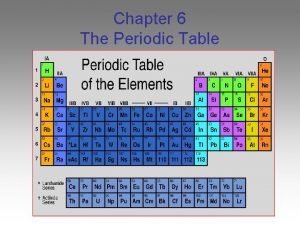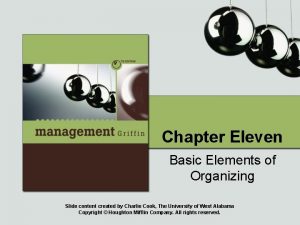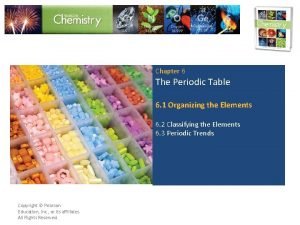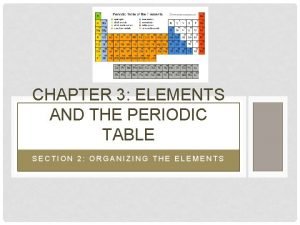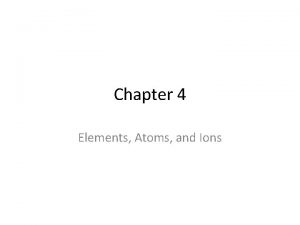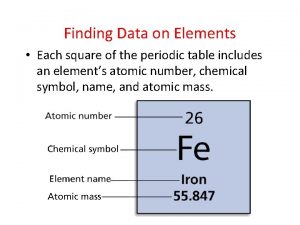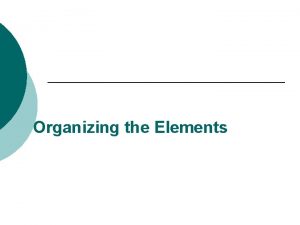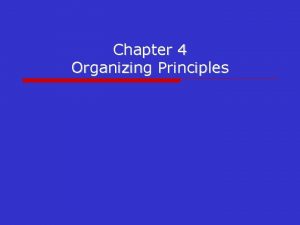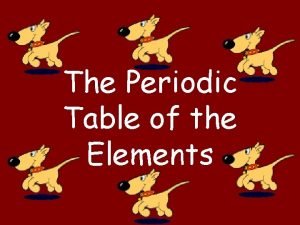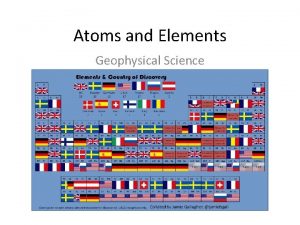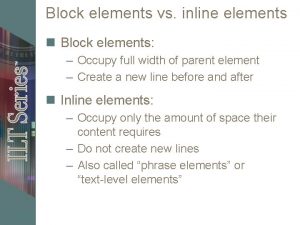Organizing Elements Chapter 6 Section 1 Organizing the

















- Slides: 17

Organizing Elements Chapter 6 Section 1

Organizing the Elements • A few elements, such as gold and copper, have been known for thousands of years - since ancient times • Yet, only about 13 had been identified by the year 1700. • As more were discovered, chemists realized they needed a way to organize the elements.

J. W. Dobereiner • A German chemist who published a classification system of the known elements in 1829 • In his system, elements were grouped into triads (a set of 3 elements with similar properties). • One element in each triad had properties intermediate of the other two elements • Johann Wolfgang Dobereiner

Organizing • Chemists used the properties of elements to sort them into groups. • Chlorine, bromine, and iodine have very similar chemical properties.

Mendeleev’s Periodic Table • By the mid-1800 s, about 70 elements were known to exist • Dmitri Mendeleev – a Russian chemist and teacher • Arranged elements in order of increasing atomic mass • Thus, the first “Periodic Table”

Mendeleev’s Periodic Table

Mendeleev’s Periodic Table • He left blanks for yet undiscovered elements – When they were discovered, he had made good predictions • But, there were problems: –Such as Co and Ni; Ar and K; Te and I

A Better Arrangement • In 1913, Henry Moseley – British physicist, arranged elements according to increasing atomic number • The arrangement used today • The symbol, atomic number & mass are basic items included-textbook pg. 162 and 163

Periodic Law • The periodic law: When elements are arranged in order of increasing atomic number, there is a periodic repetition of their physical and chemical properties. – The properties of the elements within a period change as you move across a period from left to right. – The properties of the elements within a group are the same as you move down a group

Periodic Law

Areas of the periodic table • Three classes of elements are: 1) metals 2) nonmetals 3) metalloids

Metals • 80 percent of periodic table • Good conductor of heat and electric current • All are solid at room temperature, except mercury which is a liquid • Most are malleable

Metals

Nonmetals • Most nonmetals are gases at room temperature, few are solids and bromine is the only liquid • Poor conductors of heat and electric current

Nonmetals

Metalloids • The elements that border the stair step line that separates the metals from the nonmetals are the metalloids • These can either behave like a metal or a nonmetal

Metalloids
 The periodic table displays the symbols and
The periodic table displays the symbols and Elements of organizing
Elements of organizing Basic elements of organizing
Basic elements of organizing 6.1 organizing the elements
6.1 organizing the elements Basic elements of organizing
Basic elements of organizing Elements of organizing
Elements of organizing Organizing the elements lesson quiz
Organizing the elements lesson quiz Organizing lifes diversity
Organizing lifes diversity Chapter 6 section 1 atoms elements and compounds
Chapter 6 section 1 atoms elements and compounds Chapter 6 section 1 atoms elements and compounds
Chapter 6 section 1 atoms elements and compounds Chapter 10 section 1: meiosis
Chapter 10 section 1: meiosis Hát kết hợp bộ gõ cơ thể
Hát kết hợp bộ gõ cơ thể Ng-html
Ng-html Bổ thể
Bổ thể Tỉ lệ cơ thể trẻ em
Tỉ lệ cơ thể trẻ em Voi kéo gỗ như thế nào
Voi kéo gỗ như thế nào Thang điểm glasgow
Thang điểm glasgow Hát lên người ơi
Hát lên người ơi
